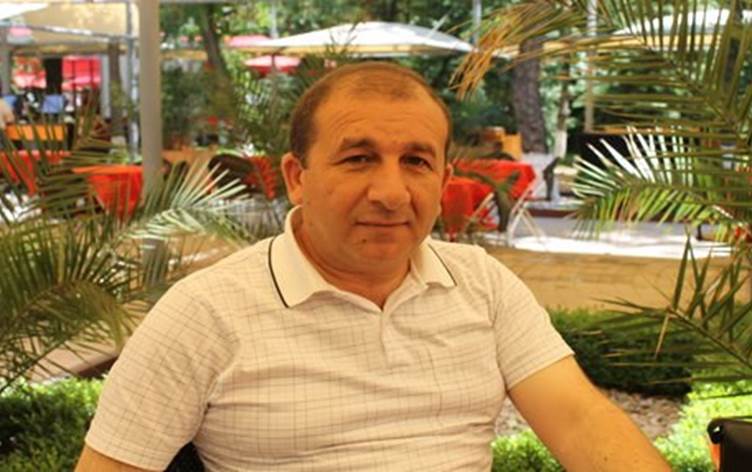YEREVAN, Armenia – As the Kurdistan Region celebrates Kurdish Journalism Day today, in distant Armenia editor Titale Kerem struggles to keep the world’s oldest living Kurdish newspaper alive.
Through its 85-year history, Riya Taze (New Path), has survived a World War, Stalin’s murderous reign that did not spare the Kurds and the collapse of the Soviet Union in 1991.
These days, its editor laments, the paper is grappling with serious issues of a different kind: loss of readership due to mass migrations of Kurds from Armenia, intra-Kurdish rivalry and financial woes.
But Kerem, who started at Riya Taze in 2010, is adamant that this important page in Kurdish publishing history must not close.
“It is vital to continue the newspaper because it is an important historical legacy as the world's longest-lived Kurdish newspaper," Kerem told Rudaw in Yerevan, the Armenian capital where the paper is based.
"There are not many Kurds left,” he said sadly, referring to the migrations, the largest after the collapse of the Soviet Union and the 1991-94 Nagorno-Karabakh war that pulled the rug from under the Armenian economy, forcing many to leave for Russia or Europe in search of livelihood.
“Those who remain cannot get paid and no one wants to work voluntarily," Kerem explained, summing up his readership and staffing problems.
At the newspaper, which began publishing a few days after Newroz in 1930, the decline is readily visible: the paper once used to publish twice and week, in color; now it comes out once a month, in black-and-white.
A blow to the newspaper was the collapse of the Soviet Union, which first cut off state funding and later sowed divisions among the Caucasian Kurds.
The Yezidi Union, which insists on its minority view that Yezidis have their own separate identity apart from Kurds, now has its own newspaper, “Yezidikhaya,” stealing readership from Riya Taze.
Unlike the majority of Kurds, who are Muslims, the Yezidis have their own controversial religious beliefs, leaving them open to attacks, especially by Islamic insurgents in Iraq.
In 2002, at the request of the Yezidi Union, the Armenian parliament recognized the Yezidis as a separate ethnicity with their own language, Ezdiki. At Armenian universities, Kurdish and Ezdiki are taught as different languages.
But Kerem, who calls himself “a Kurd by ethnicity and Yezidi by religion,” disagrees with the arguments of the Yezidi Union, noting that Ezdiki sounds just like the Kurdish Kurmanji dialect.
"How do we understand each other now? Because we speak the same language and even the same dialect, Kurmanji,” he said.
Riya Taze traces its name to the new beginning its founders sowed in a new country, where they arrived to escape Turkish pogroms against Kurds and Armenians.
"For our people, it was a new path, new start and new country after the escape from the Ottoman killings and repression; hence, the name Riya Taze," Kerem said.
The large numbers of Kurds who fled the Ottoman Empire in the 19th century were mostly Yezidi Kurds from Turkey who settled in the Transcaucasus, mainly Armenia, Azerbaijan and Georgia.
Kurds in Armenia, who numbered 60,000 when they first arrived and numbered half that size in a 2011 census, are the largest minority in the mainly Christian country.
At a time when the Kurdish language and culture were banned in Turkey, they flourished in the Caucasus, brought there by immigrant Kurds.
Zare, considered the first Kurdish film, was shot in Armenia in 1926; the first Kurdish novel, Shvane Kurd, was published in Armenia in 1935; the first Kurdish radio aired in the 1940s from Yerevan, where the Kurds enjoyed a daily 90-minute broadcast of Kurdish folk and classic songs. Secretly, they were also heard in Turkey.
Riya Taze was founded by the Kurdish-speaking Armenian editors Hrachya Kochar, Herutiyun Mikirtchyan and Gevork Paris, and was printed in the Latin alphabet, developed by Arabe Shamo and Isahak Marogulov.
"The Armenian editors were originally from the Kurdish areas in eastern Turkey, from where they fled after the genocide against them in 1915. They had grown up among Kurds, so they spoke good Kurdish," Kerem explained.
The first man in charge of the newspaper was the Kurd Cerdoye Genco.
Riya Taze functioned as an organ of the Soviet Communist Party. It served the Communist Party and carried out its propaganda in Kurdish, originally aimed at Kurds living in the Soviet Union. In the 1930s, its programs were heavily influenced by Soviet propaganda, focusing on the education of society in the Marxist-Leninist spirit of “the brotherhood of peoples.”
The paper was forced to close by the Soviet authorities in 1937. When it reopened in 1955 after an 18-year hiatus, its alphabet had changed to Cyrillic.
“Since it was published in Cyrillic script in the years following the 1950s, Kurds outside the Soviet Union were not able to read it,” Kerem explained.
It reached its second heyday, again becoming a “school for Kurdish intellectuals” -- according to Kerem – in the 1980s, with a weekly publication and 20 staff. In 2000, it began reprinting in the Latin alphabet.
Kerem, who studied English at the University of Yerevan and has worked many years for Radio Yerevan, wants to keep the paper going in order to keep the Kurdish voice alive in Armenia.
"Journalism is very important for any society,” he said. “We need Riya Taze so Kurds here can continue to have a voice."



Comments
Rudaw moderates all comments submitted on our website. We welcome comments which are relevant to the article and encourage further discussion about the issues that matter to you. We also welcome constructive criticism about Rudaw.
To be approved for publication, however, your comments must meet our community guidelines.
We will not tolerate the following: profanity, threats, personal attacks, vulgarity, abuse (such as sexism, racism, homophobia or xenophobia), or commercial or personal promotion.
Comments that do not meet our guidelines will be rejected. Comments are not edited – they are either approved or rejected.
Post a comment